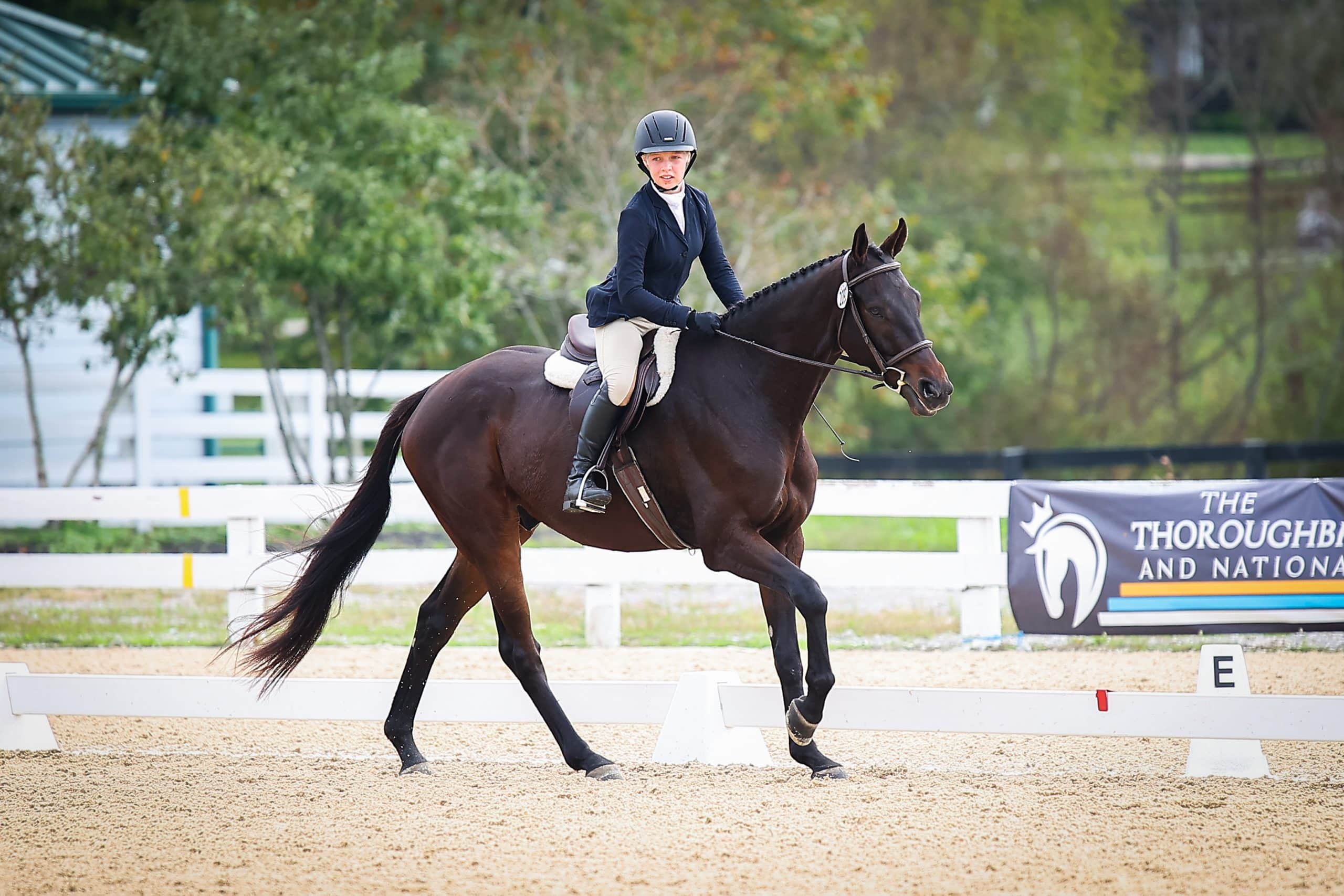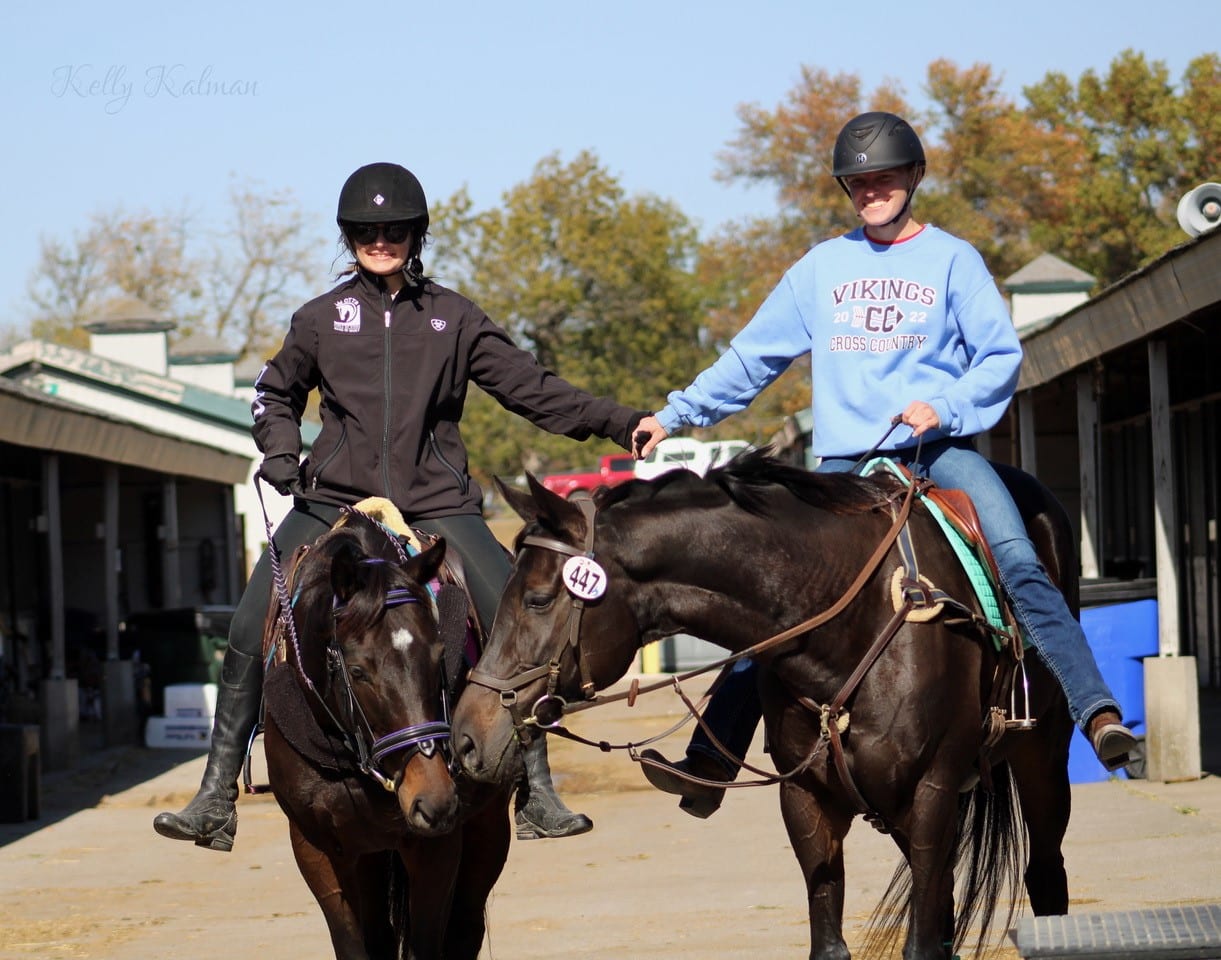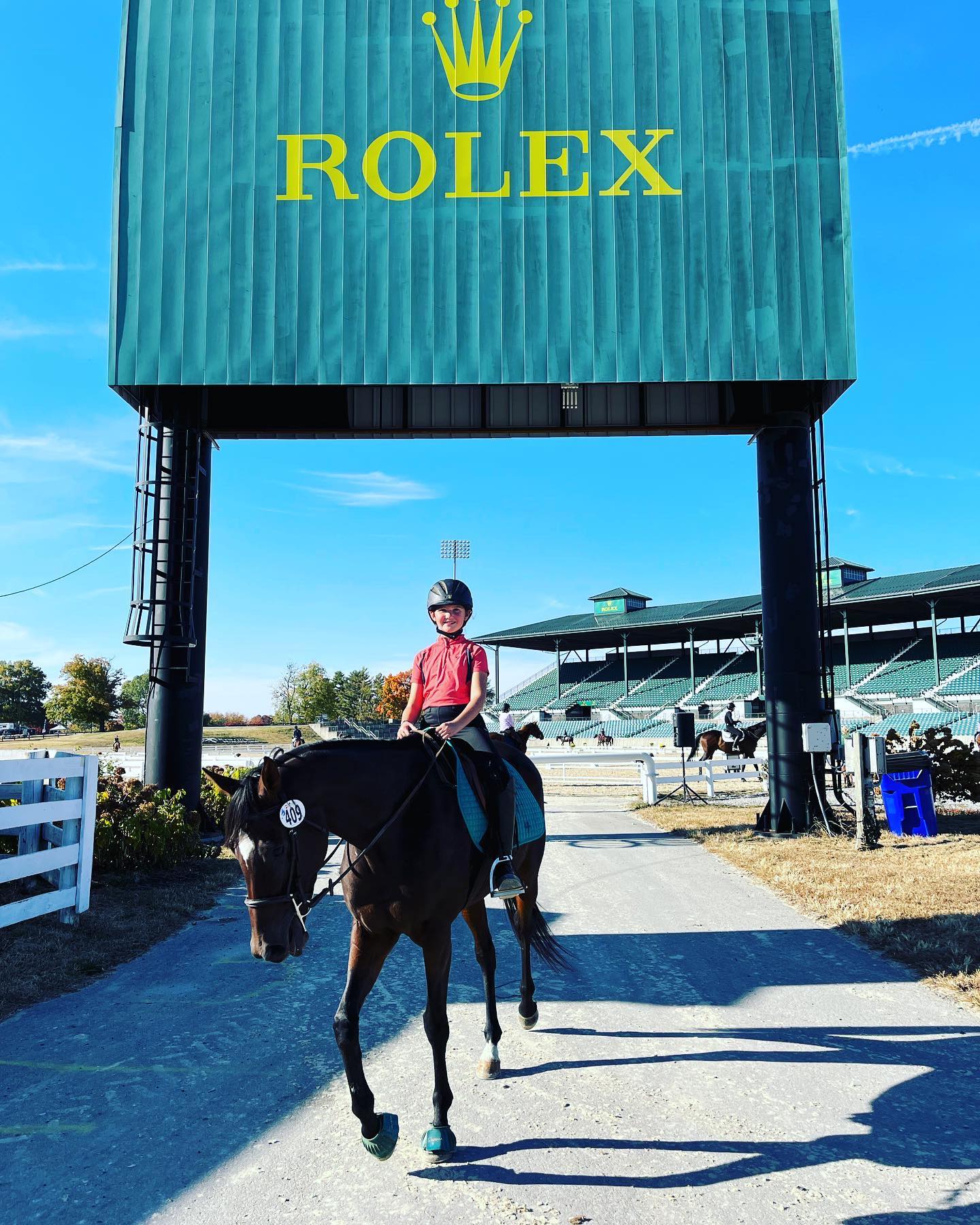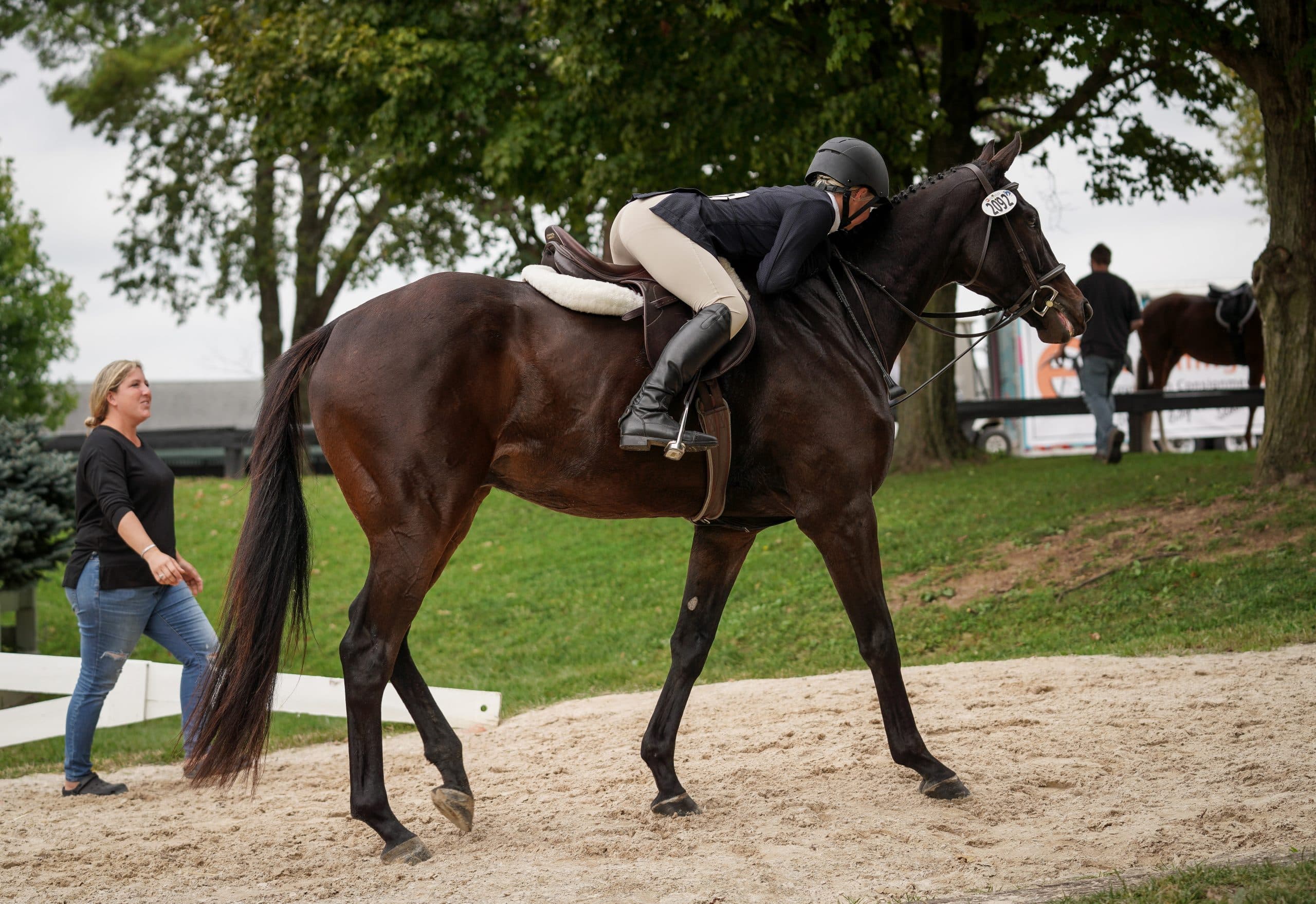
Then 13-year-old Summer Chestnut and Galan at the 2021 Thoroughbred Makeover. Photo courtesy CanterClix
It might sound dreamy: Buy your horse-crazy teen a recently retired racehorse she can train for her chosen sport, build an unbreakable bond with and enjoy for a decade or more to come. Yes, this fairy tale can become reality. But for parents considering getting a horse off the track for a kid, preparation, education and commitment are key to success. Three parents of Thoroughbred Makeover graduates share their journeys and offer their advice for moms and dads in similar situations.
Learn About the Breed
Off-track Thoroughbreds are appealing sport horse prospects for many reasons. They’re typically less expensive than imported Warmbloods, they often retire from racing young and with a solid training foundation and they’re bred to be athletes. It’s easy to understand why a parent in the market for a horse might find themselves scrolling past one social media post advertising an elegant OTTB after another and think, “This is the perfect type of project for my kid!”
First, make sure your child is prepared to work with a Thoroughbred. Kelly Kalman’s daughter, Sadie, for instance, has been volunteering at Thoroughbred rehabilitation and rehoming center After the Races since she was 10. It was there the now 18-year-old from Pennsylvania fell in love with the breed and learned about the Retired Racehorse Project. So when she got Sassy and Hot (Stormin Fever — Sassy Suances, Suances [GB]) for the 2022 Makeover, she was well-prepared to begin her retraining.
“Take your time to get your child involved with the breed before you just go out and get one,” says Kalman. “Volunteer at barns that rehabilitate them.”
It also helps if you’re working with a trainer who’s familiar with the breed. “I would recommend that you are at a supportive barn that has experience with OTTBs and training green horses,” says Michelle Chestnut, who lives in Riva, Maryland. Her 14-year-old daughter, Summer, got her first horse, Galan (Gone Astray — The Marikutana, Congrats), and competed in Show Hunter and Dressage at the 2021 Makeover. She had already been riding at a barn that has many Thoroughbreds, so when the Chestnuts began their horse search, they knew an OTTB was a possible option.
Megan Cummings, of Statesville, North Carolina, who in January 2022 adopted Socially Astray (Gone Astray — Social Security, Notebook) for her 12-year-old daughter, Hailey, learned the importance of finding the right trainer firsthand. During their journey to the Makeover, she realized Hailey and “Star” weren’t progressing as they should at the facility where they boarded, so they moved to a barn better equipped to work with a young rider and OTTB and have since flourished.
Many resources and forums dedicated to the OTTB exist for parents to learn more and seek advice — from TheRRP.org’s educational library to social media communities like the RRP’s Thoroughbred Makeover group.
“There are so many resources for (people with) OTTBs; you become part of a horse community,” says Chestnut. “And whenever you need help, if you reach out to the OTTB community, you will always find help and/or fun events to participate in with your OTTB.”

Sadie Kalman (left) with her 2022 Makeover horse, Sassy and Hot, volunteered at a Thoroughbred rehoming organization for years, gaining experience working with the breed before retraining her own. Photo courtesy Kelly Kalman
It’s a Commitment
Horse ownership of any kind is a major commitment — we all know that. Parents have the added responsibilities of not only paying for their child’s horse, lessons and shows but also driving them to the barn, spending weekends at equine events and supporting them through training setbacks.
“Lessons, training rides, clinics, camps, field trips and shows are all the things you will find yourself committing to,” says Chestnut. “As a parent, are you willing to take your kid to the barn four to five days a week? Are you willing to give up evenings and weekends for lessons, clinics and shows? Is your rider mature enough to tack, groom and care for the horse on a daily basis?”
Hailey proved to her mom her unfailing dedication to Star when the mare sustained a hock injury last year that required multiple hospitalizations. Cummings drove her daughter out to the barn seven days a week to care for the mare but says her daughter never complained about the work and time involved.
“She’s 12, so I was having to take her everywhere, make sure she had everything she needed for Star, pay the vet bills,” she says. “It was a huge commitment but so rewarding, and they are just the best friends. It’s like I have two teenage girls!”
Navigating the Retraining Process
Retraining a Thoroughbred off the track poses unique challenges but can be incredibly gratifying. When giving a junior rider that responsibility, parents should understand the training stages and be prepared to support their child when progress is slow.
“You are starting from scratch and training the horse for a new career, whether it may be a hunter/jumper or a barrel racer,” says Chestnut. “You are not purchasing a horse that is going to be show-ready. It can be one step forward and two steps back sometimes, but that is part of the amazing process.”
“I have tried to tell many parents that you can’t just get on without groundwork,” adds Kalman. “Some of these horses need to learn how to stop and steer. It’s a process, but I think it’s an amazing experience for a junior rider — as long as the parent is comfortable with assisting or getting any training needed with the breed.”
Working closely and consistently with a skilled trainer can help prevent horse and rider from developing a shaky foundation or bad habits that will be harder to fix later on.
“An OTTB is a horse for a young rider who wants to be part of the training process and work closely with their horse,” says Chestnut. “An OTTB is for a rider who will respect the feedback of what needs to be worked on and enjoy the next training session and homework they receive.”
Encourage your young rider to put in the hard work and be part of the decision-making process when it comes to training and caring for the horse. Take them to clinics to learn from different professionals, and go to local shows or off-property outings for extra miles.
“You are there as a guide,” Chestnut says. “You can’t do it all for them — this is their experience, and you are along for the ride and being a cheerleader.”
It can take years for these horses to understand and be confident in their new careers, which can be an exercise in patience for both rider and parents.
“Your child will learn patience and humility working with an OTTB, or any horse really,” Kalman says. “It’s probably the best thing you can do for your kid.”

Megan Cummings drove her 12-year-old daughter, Hailey, to the barn seven days a week to care for Socially Astray when the mare battled injury. Photo courtesy Megan Cummings
A Lasting Bond
Putting in the time and miles to retrain an OTTB allows horse and rider to truly get to know each other and build a strong bond. The rider gets to experience each of the horse’s firsts — first course, first trail ride, first horse show. Intelligent and athletic, OTTBs can give dedicated young riders long-lasting partnerships.
“A well-trained OTTB can be a forever horse for a rider,” says Chestnut.
These three mothers of OTTB-crazy daughters agree that every discouraging ride and late evening at the barn is a small price to pay for the beautiful relationships that develop.
“In the end all your time will be worth it,” says Kalman. “I have yet to meet (a Thoroughbred) that didn’t give its heart and soul to you.”
Cummings, whose family also has an Arabian, a Paint and a Welsh Cob mix, says Hailey wouldn’t want any other breed. “What a Thoroughbred can do is just incredible,” she says. “To take her from the dressage arena to the competitive trail class and then pop over some jumps — it’s just crazy to me.”
Take-Home Message
Are you still scrolling through social media posts about OTTBs, looking for your child’s first or next horse?
“If your rider is mature enough and has a good riding foundation, I say go for it,” says Chestnut. “But it takes a village. Seriously. The parents, rider and professional trainers are a team. Are you willing to have some training setbacks as part of the journey? Are you ready to jump for joy when your rider and horse get the right lead and do well at a show? If your answer is yes, you will love this experience.”

Summer Chestnut: “A well-trained OTTB can be a forever horse for a rider,” says Michelle Chestnut, whose daughter, Summer, competed in Dressage and Show Hunter at the 2021 Makeover. Photo courtesy CanterClix

